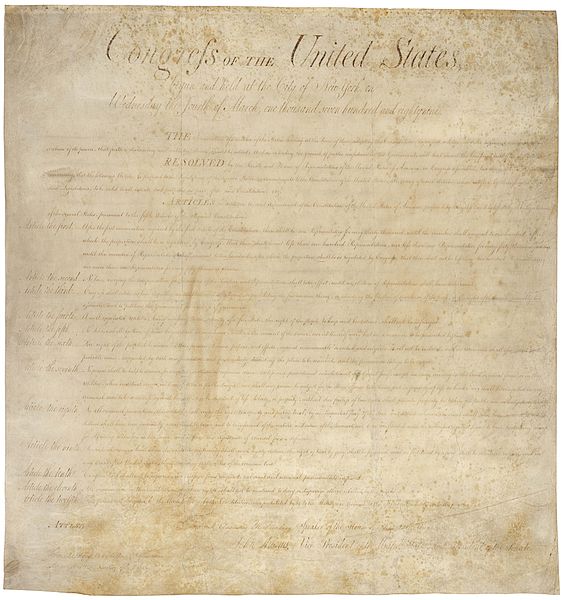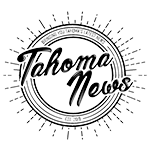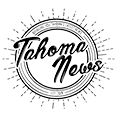Part I: Shall Not Be Infringed…
A look at the history and arguments surrounding gun violence.

The Bill of Rights outlines the first 10 constitutional amendments. The 2nd Amendment has been a topic of controversy in recent years. Photo used under Creative Commons.
March 13, 2018
This is part I in a series detailing the history and arguments surrounding guns and gun violence.
In 1791, the Bill of Rights included the second amendment, the right to bear arms. Since then, our country has had a large controversy over the issue of guns and their uses. Here is a history of the issue.
Legislations surrounding guns were very lax until 1927, this was the year that the first major restriction was placed on guns. Congress passed a law prohibiting people from mailing concealed weapons. In 1924, California passed laws that prohibited the use of a concealed weapon without the use of a permit. This law was put into effect due to the support of the KKK in an attempt to get concealed guns out the hands of legal Latino and Chinese immigrants.
The National Firearms Act of 1934, a law that restricted the manufacturing and sale of fully automatic weapons, was passed by Congress. This marked the first restriction on the actual production and sale of a gun, as opposed to how it should be used. Along the same lines, the Federal Firearms Act of 1938, was the first restriction placed on selling an ordinary firearm. In order to buy a gun, people now needed to obtain a permit, costing $1, in order to legally own a gun. This act also prohibited convicted felons from being able to purchase firearms.
In 1949, we see the first mass shooting occur. On September 5, 1949, an army veteran named Howard Unruh, killed 13 people in his neighborhood while walking around. He was later arrested and diagnosed with schizophrenia. This was the first mass shooting to be recorded in modern America. Thus, slowly began the talk of restrictions on Firearms. The second mass shooting took place on August 1st, 1966. Charles Whitman killed 16 people and injured 31 when he open fired in the University of Austin Texas’s Clocktower. He continued shooting until he was shot and killed by police officers.
Thirty years after the Federal Firearms Act was passed, another piece of legislation was passed. The Gun Control Act of 1968, prevented those who were underage, had a criminal record, or had a history of mental illness, from being able to own guns. It also provided more restrictions on the sale and record keeping on guns as small as handguns, as well as regulating imported guns.
In 1972, the Bureau of Alcohol Tobacco and Firearms (ATF) was created to help enforce federal firearm laws and restrictions on the illegal use and sale of firearms. The ATF now issued the licenses and documentation necessary to be able to own a gun.
In 1984 a man named James Oliver Huberty shot and killed 21 people in a Mcdonald’s Restaurant, he was killed by a police sharpshooter. As the 80’s continued, laws and regulations became harsher as it was clear gun violence was becoming a larger issue. The Armed Career Criminal Act (1986), increased penalties for those who failed to comply with laws about firearms. However, the Firearms Owner Protection Act (1986) relaxed some of the restrictions for firearms and owners not associated with crimes. Due to a large number of available guns and public opinion against Gun Control, gun violence continued to become a larger issue. The Law enforcement Protection Act (1986) stopped the sale of bullets with the ability to penetrate bulletproof vests. A postal worker named Pat Sherrill shot and killed 14 people at a post office and then shot himself also in 1986. He did so because he was soon to be fired.
After the Cleveland Elementary School shooting in 1989, which killed 5 children, California banned the possession of semiautomatic assault weapons.
Then we reach the nineties. In 1990 the Crime Control Act continued to impose regulations on the manufacturing and importing of semi-automatic assault weapons, it also established “Gun-Free school zones” in an effort to increase penalties for those bringing guns to schools.
On October 16, 1991, George Hennard shot and killed 23 people and himself, as well as injuring 20 others in the attack. In 1994, a five day waiting period was enforced and police then were required to perform background checks on those wishing to purchase guns under the Brady Handgun Violence Protection Act. In 1997 in the case of Printz vs. THe United States, the Supreme Court deems the background checks made law by the BHVPA unconstitutional. Manufacturers also begin to put child safety locks onto all new guns being made.
Congress in 1998, required gun makers to make additions to triggers that would create safety locks, after an original bill was made to force all guns to be made with a safety feature. On November 30, companies were then required to check criminal backgrounds. In December of that same year, President Bill Clinton reported that the forced FBI background checks on all gun purchases stopped around 400,000 illegal gun purchases. 1999, the first modern school shooting took place. While shootings in schools had happened sporadically, many consider the incident at Columbine High School to be the beginning of a national crisis.
Students Eric Harris and Dylan Klebold opened fire at Columbine High School in Littleton Colorado. They killed 12 classmates, 1 teacher, and injured 26 others, then shot themselves in the school library. That same year, after a very close margin, the U.S. Senate voted to require trigger locks on all guns manufactured and extended the waiting period and background check requirements to buy guns at gun shows.
Media coverage has sensationalized school shootings and tragedies, but the seemingly increasing commonality in these acts of violence makes them a hallmark of our modern cultural landscape. But the roots of these acts of violence are varied and difficult to sort through. As this debate continues and students continue the regulations have continued to range the entire political spectrum.
Part two of this series will focus on the arguments from both sides of the gun violence debate.


